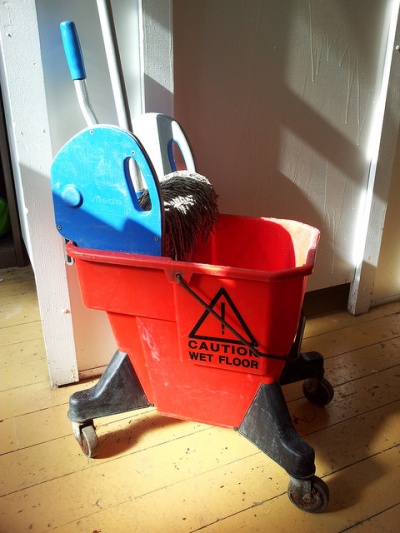Cleaning the hackspace: Difference between revisions
| Line 43: | Line 43: | ||
= How to get to the bins = | = How to get to the bins = | ||
Go through the back doors of the Hackspace, past the [[Metalworking Area]]. Follow the corridor along and around to the right, where you will reach the lift. exit on the ground floor to Roden Street, enlist a buddy to hold the doors and steer the trolly on the sloping pavement, Turn left and left again on liverpool street, the bins are accessed via the door at the side of the shutters. See picture, the code for the | Go through the back doors of the Hackspace, past the [[Metalworking Area]]. Follow the corridor along and around to the right, where you will reach the lift. exit on the ground floor to Roden Street, enlist a buddy to hold the doors and steer the trolly on the sloping pavement, Turn left and left again on liverpool street, the bins are accessed via the door at the side of the shutters. See picture, Ask on slack or email for the code for the bin door | ||
Revision as of 18:21, 22 January 2023
- See also: Reoccurring tasks and Waste and Recycling Initiative
| Overview |
|---|
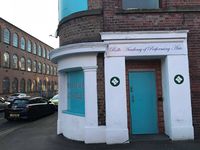
|
| The Space • Location • New Members • Tools • Events • Teams • Projects |
| Volunteering • Infrastructure • Network • Members • Action List • Donations Pledge Drives • Meeting • Financials Branding • Suppliers • History |
Cleaning and maintaining the workspaces in the hackspace is the responsibility of the membership.
Expectations
There is no formal organised cleaning or cleaners for the workshops and creative areas, although from time to time, contractors are employed for the Domestic spaces upstairs this is limited to the kitchen and toilets. Please build time into your visit to clear up the area where you have been working and put away any equipment you have used. if you exhaust or use consumables please consider replacing what you have used or notify the relevant team on slack.
Clearing up and cleaning are important for the Safety of those using the space, be sure benches and machines are thoroughly cleaned down after use, if the bins and tool waste receptacles are full these will need clearing as well, this is your job.
larger items of waste, abandoned projects and left over large materials present an undue physical and administrative burden on volunteers, They are also expensive for the space to remove as commercial waste, members should remove abandoned personal projects an Items themselves to avoid undue expense for the space.
If you notice someone lumping together bin bags and off-cuts for a trip to the bins, feel free to offer help as managing the doors and spilly piles of rubbish can be cumbersome, it is also an opportunity to engage with fellow hack-spacers.
Laser Off-cuts
Please take responsibility of any off cuts you generate, Save on chores by putting it in the outside red bins as you leave. trim any useful waste up on the bandsaw so it can be easily stored as waste or donated for use.
Bin Bags, cleaning materials and gloves
Bin Bags are normally under the sink in the kitchen, other materials can be found in the vicinity of sinks in the workshop or inside the door of the workshop on the adjacent shelves.
Wood off-cuts
The space generates a huge amount of off-cuts, normally these go to the general waste, feel free to use creatively in your own projects. Some members have raided the wood off-cuts bin for burning at bonfire parties and the like, clearly done at your own risk, burning paint and glue found on waste wood and timber composites can generate volatile toxic fumes, also fire, so lets be careful out there.
Dust bags from woodwork machinery exhausts
Wear dust mask and gloves, Sawdust can be placed in the general waste but must be bagged, overfull bags may need partial transfer in order to be removed from the space, make sure all bags are sealed up as to not spill and contaminate the corridors as the the bags are removed from the space. Hint, bags with dust can be compressed by inserting a vacuum cleaner hose in the neck before tying up.
How to take out the rubbish
Locate Bin bags, normally to be found under the kitchen sink, remove the full bags from the bin TAKE CARE FOR SHARPS, WEAR SUITABLE GLOVES, Replace the old bin liner.
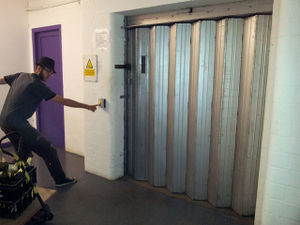
Before throwing stuff away, please be aware of our Waste and Recycling Initiative.
Remember to take your RFID door access card and your phone, so you can get back in, or contact someone if there is a problem.
Where are the Bins?
Ask on slack or e-mail trustees for the code for the bizspace bin door. The rubbish bins are located at the back of the building on Liverpool street and are accessed via the lift. They might be on Roden Street on bin days. Use the lift or stairs to the Roden street entrance, Turn left out of the door and left again
The wheeled trolleys in the Hackspace workshop are useful to shift large amounts of rubbish, usually found near the Metalworking Area. but could be downstairs, the shopping trolly is particularly useful for this activity.
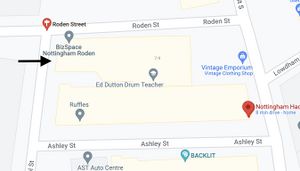
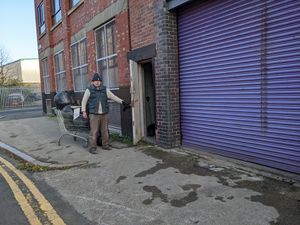
How to get to the bins
Go through the back doors of the Hackspace, past the Metalworking Area. Follow the corridor along and around to the right, where you will reach the lift. exit on the ground floor to Roden Street, enlist a buddy to hold the doors and steer the trolly on the sloping pavement, Turn left and left again on liverpool street, the bins are accessed via the door at the side of the shutters. See picture, Ask on slack or email for the code for the bin door
The waste collections are every Tuesday and Thursday morning and is sorted by the contractors for recycling The bins are frequently filled by other Bizspace tenants, Tuesday evening is normally the best day to find the bins with capacity.
Do not dump rubbish anywhere in the shared / public parts of the building. BizSpace are very strict about this, and charge £50 per 'offence'. Remember you are on CCTV in the public parts of the building!
Mopping the floors
Tips for quick spot cleaning
There is a small (blue) domestic mop and bucket for cleaning small patches. This mop is usually stored in the kitchen. At the moment we don't have any "caution, wet floor" signs, but the large red mop bucket has a "caution" sign on the side, so it can be left out until the spot dries.
Tips for thorough mopping
| Information in this section is out of date. The specific problem is: A few TODO's regarding techniques here. Also some text about 2012 in here that probably isn't needed Please help update the page if you can. The talk page may contain suggestions. (Feb 2019) |
- Choose a time when few people are around, so the floors have time to dry.
- Fold the tables where possible and stack chairs before you begin (this pays off later).
- (Probably we should put up a "caution, cleaning in progress" sign on the door, but we haven't bothered so far.)
- Use our water heater to boil the water (it is stored above the cupboards in the kitchen). Note: our kettle is small so you would have to wait for it to boil many times.
- We have a big red bucket with castors and a blue wringer (see cleaning equipment).
- We only have one floor cleaning product at the moment (the orange stuff under the kitchen sink) and we're nearly out (21:02, 10 May 2012 (EST)). It is recommended to avoid washing-up liquid, because this can make masses of bubbles and slippery residue that's hard to get off the floor again. TODO: look into appropriate floor cleaning products without bleach.
- This is a recommended mopping technique to clean a large area quickly, and take up most of the water again so it dries quickly:
- TODO: describe technique.
- Important: Only empty the dirty water into the workshop sink, not the kitchen one (for hygiene).
- Important: After you use the mop, squeeze out the water and leave the mop head loose so it can dry. If the mop is left wet it will rot and get smelly.
Cleaning equipment
We have a mop bucket with a Vileda wringer and an SYR InterChange mop handle (920045). These 16oz replacement mop heads should fit our handle:
- SYR No 16 PY Mop (991983)
- SYR No 16 Twine Socket Mop (991986)
